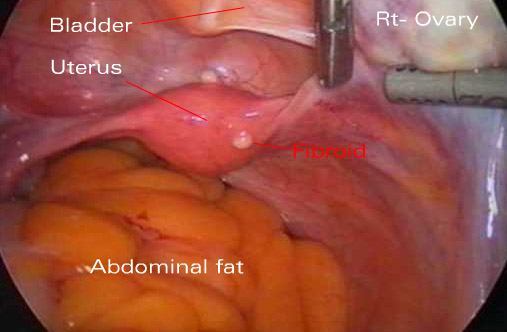
Laparoscopic view of pelvis showing uterine fibroid.
Also called as myomas, fibromyomas or leiomyomas, Fibroids are non-cancerous tumours of the uterus that appear during your childbearing years. Fibroids can appear on the inside or outside lining of your uterus, or within its muscular wall. They usually develop from a single smooth muscle cell that continues to grow.
Fibroids often cause no problems, but may occasionally be associated with infertility, miscarriage and premature labour. Other possible problems include heavy, lengthy and painful periods. Treatment depends on the size, number and location of the fibroids, but may include drugs and surgery. Fibroids rarely turn cancerous.
Fibroids often cause no problems, but may occasionally be associated with infertility, miscarriage and premature labour. Other possible problems include heavy, lengthy and painful periods. Treatment depends on the size, number and location of the fibroids, but may include drugs and surgery. Fibroids rarely turn cancerous.
- Fibroids are growing large enough to cause pressure on other organs, such as the bladder.
- Fibroids are growing rapidly
- Fibroids are causing abnormal bleeding
- Fibroids are causing problems with fertility.
Symptoms
In many cases, fibroids are asymptomatic. Symptoms may include:
- Heavy periods
- Lengthy periods
- Period pain
- Spotting between periods
- Painful intercourse
- A sensation of heaviness or pressure in the back, bowel and bladder
- Frequent urination
- A lump or swelling in the lower abdomen.
Different types
Fibroids are categorised by their location, which includes:
- Intramural - growing in the uterine wall. Intramural fibroids are the most common variety.
- Submucosal - growing in the uterine lining (endometrium). This type tends to cause excessive menstrual bleeding and period pain.
- Subserosal - growing on the exterior wall of the uterus. They sometimes appear like long stalks.
Endometrial polyps
Fibroids can prompt the growth of polyps in the uterine lining (endometrium). A polyp is a small protrusion that looks like a tiny ball on the end of a slim stalk. Endometrial polyps can also contribute to menstrual problems, such as excessive bleeding and pain.
Fibroids can prompt the growth of polyps in the uterine lining (endometrium). A polyp is a small protrusion that looks like a tiny ball on the end of a slim stalk. Endometrial polyps can also contribute to menstrual problems, such as excessive bleeding and pain.
Common complications
Fibroids can cause a variety of complications, including:
Fibroids can cause a variety of complications, including:
Anaemia - excessive menstrual blood loss can cause anaemia, a disorder characterised by the body's inability to carry sufficient oxygen in the blood. Symptoms of anaemia include breathlessness, fatigue and paleness.
Urination problems - large fibroids can bulge the uterus against the bladder, causing a sensation of fullness or discomfort and the need to urinate often.
Infertility - the presence of fibroids can interfere with implantation of the fertilised egg in a number of ways. For example, the egg may try to burrow into a fibroid, or fibroids close to the uterine cavity may'prop open 'the uterus, which makes successful implantation difficult.
Miscarriage and premature delivery - fibroids can reduce blood flow to the placenta, or else compete for space with the developing baby.
Diagnosis methods
Fibroids can be detected using an ultrasound, where sound waves create a two dimensional picture. The inside of the uterus can be examined with a hysteroscope, which is a thin tube passed through the cervix (neck of the womb). A small camera may be placed at the tip of the hysteroscope, so that the interior of the uterus can be viewed on a monitor.
Fibroids can be detected using an ultrasound, where sound waves create a two dimensional picture. The inside of the uterus can be examined with a hysteroscope, which is a thin tube passed through the cervix (neck of the womb). A small camera may be placed at the tip of the hysteroscope, so that the interior of the uterus can be viewed on a monitor.
Treatment
Most fibroids do not cause symptoms, and do not require treatment. A 'wait and see' approach is sometimes adopted.
- Fibroids may require treatment in the following circumstances:
- Fibroids are growing large enough to cause pressure on other organs, such as the bladder.
- Fibroids are growing rapidly
- Fibroids are causing abnormal bleeding
- Fibroids are causing problems with fertility.
Treatment options
Treatment depends on the location, size and number of the fibroids, but may include:
- Drugs - such as hormones, used in combination to shrink the fibroids prior to surgery.
- Hysteroscopy - the fibroids are removed via the cervix, using a hysteroscope.
- Laparoscopy - or 'keyhole surgery', where a thin tube is inserted through the abdomen to remove the fibroids.
- Open surgery - larger fibroids need to be removed via an abdominal incision. This procedure weakens the uterine wall, and makes Caesarean sections for subsequent pregnancies more likely.
- Hysterectomy - the surgical removal of some, or all, of the uterus. Pregnancy is no longer possible after a hysterectomy.







